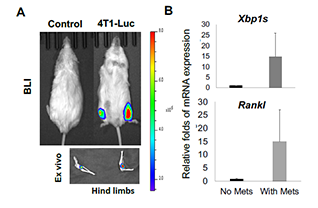
The interactions between breast cancer cells (BCCs) and bone microenvironment (BM) enhance BCC growth, render them drug resistant, and mediate BCC-induced bone destruction, resulting in increased mortality and compromising life quality of breast cancer patients. Bone marrow stromal cells (BMSCs) are progenitors of skeletal tissue components such as bone, cartilage, the hematopoiesis-supporting stroma, and adipocyte-lineage cells. These cells are considered a key player in the BM support of breast cancer bone metastasis (BCBM). BMSCs secret many chemokines, growth factors, exosomes, and inflammatory cytokines to promote homing, survival and growth of BCCs in BM, induce dormancy and consequent drug resistance of BCCs, and activate osteoclasts, the bone resorbing cells, to induce osteolytic lesions in bone. We reason that BMSCs need to upregulate their capacities of protein folding and trafficking in order to accommodate their increased protein synthesizing and secretion activities.
The tumor bone microenvironment exhibits heightened inflammation, hypoxia and nutrient-deprivation, all of which are potent inducers to activate ER stress signaling. X-box binding protein spliced (XBP1s) is a basic-region leucine zipper (bzip) transcription factor of the CREB-ATF protein family and a major proximal effector of ER stress signaling. Upon ER stress, Xbp1 mRNA is spliced via an ER-localized endoribonuclease/kinase Inositol Requiring Enzyme-1α (IRE1α) to generate spliced Xbp1 mRNA, termed Xbp1s, from unspliced Xbp1 (Xbp1u). Xbp1s encodes an active transcription factor (XBP1s) that drives gene expression of a wide range of molecules involved in maintenance of intracellular protein homeostasis.
We discovered that human XBP1s (hXBP1s) is a stromal-intrinsic oncogenic factor that enables BMSC support of multiple myeloma (MM) cell growth and MM-induced bone destruction in multiple myeloma bone disease (MMBD). MM patient BMSCs have a heightened level of protein expression of hXBP1s, compared with normal donor BMSCs. Overexpression of hXBP1s in human BMSCs (hBMSCs), KM101 cells, granted them an array of pathological features of MM BMSCs and thus enhanced stromal support of MM cell growth and osteolysis both in vivo and in vitro. Knocking down hXBP1s in MM BMSCs leads to significant reversal of MM BMSCs’ pathological behaviors. Similar to MMBD, 70% of BCBM are osteolytic. Intriguingly, the BCC-intrinsic XBP1s was recently found to be an important oncogene that renders drug resistance and relapse of triple negative (TN) BCCs. We hypothesize that the stromal IRE1α /XBP1s pathway is also an essential pathogenic factor that potentiates the stromal support of BCC growth and BCC-induced osteolysis, and thus a potential novel therapeutic target for disrupting the stromal support to the progression of BCBM. Upon successful completion, our studies could provide an important rationale for targeting the IRE1α/XBP1s pathway for treating breast cancer. Such a therapeutic strategy could likely achieve an effect of killing two birds with one stone – overcoming drug resistance and relapse of BCCs and disrupting the stromal support to BCBM simultaneously.